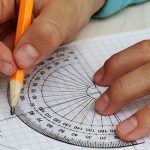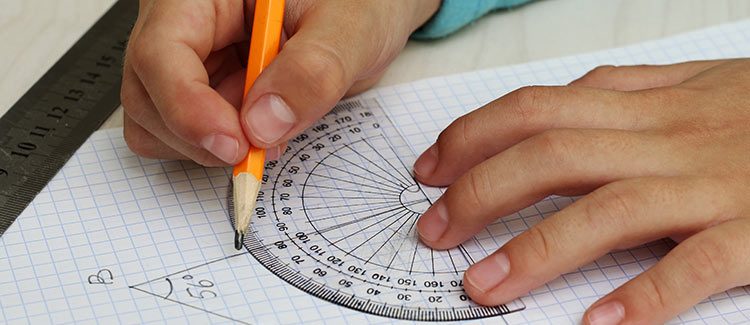Math is getting more abstract. You can help your child keep what they’re learning fun and relevant to their everyday lives. Here’s how.
-
Looking at things from a new angle
Your child’s back-to-school list included an odd-shaped instrument that came with their ruler. Yes, the protractor! Help your child get more comfortable using it with a little project. Send your child on a search for angles in your house that are not right angles. Have them list what they find, whether it’s obtuse or acute, and measure the angle using their protractor. Don’t have a protractor handy? Use the top of this worksheet to complete this project.
-
A new angle on angles
If you’ve got a door, you can help your 4th grader understand a key new math concept: angles. Open the bedroom door so that it sticks out straight from the frame to create a right angle (90°). Next, have her close it some, so she would have to squeeze through.That’s less than 90°, an acute angle. Open it more than halfway and it’s totally obtuse. Use this worksheet to clarify!
-
Want cookies? Learn fractions!
Make cookies together, but use only the 1⁄2 cup for measuring. This lets your child practice working with equivalent fractions. For example, for one cup of flour, your child fills the 1⁄2 cup two times. And for 1⁄4 cup of water, fill the 1⁄2 cup halfway. Give your child some practice with adding simple fractions with this worksheet.
-
Chart those cartwheels!
Ask your child to choose a physical feat to attempt. (Run 100 yard dash, say, or do 5 cartwheels in record time.) Use the first activity as the baseline time. Then have your child do the feat 3 more times, clocking each. Have them draw a chart. Also ask what their next time might be if they did it again and to explain why they think that. Learn more strategies for making math fun at home.
-
To the millions (Prepping for counting their money!)
When you come across a large number in a book or magazine, ask your child to tell you which number is in the millions place, the thousands place, the hundreds place, and so on. Try this worksheet, too. Practice saying the number out loud.
-
The power of practice
When you want to get good at something, you practice. Fourth graders need to show no fear when multiplying 3- and 4-digit numbers by single numbers or multiplying two 2-digit numbers. So print out some worksheets and have them practice, practice, practice!
-
Fractions & decimals
Is ¼ greater than .31? It’s pretty easy if you know that ¼ is .25. These are the sorts of problems your fourth grader will face. Kids need to know how fractions can be turned into decimals and vice versa. Can your child do it? Test them. Give your child a list of decimals and fractions and have them draw them on a number line. Give your child practice with these three worksheets: Comparing and ordering decimals, Comparing fractions, and Converting fractions to decimals.
-
Logical guessing
Fourth graders are getting more logical and have picked up skills to help them figure things out. Your child should be able to estimate how many marbles in a jar, jelly beans in a bag, or cars in a parking lot. Challenge them! When you’re at a movie (or anywhere with a crowd), ask them to estimate how many people are in the room and to explain their reasoning. (Don’t let them count each head.) Give your child more practice estimating with this worksheet.
-
One small first step
(May)
It may seem hard to believe, but your child’s been on the road to algebra and linear equations all year long. One way to help your child at this stage is to introduce the concept of finding and plotting points on a grid. Use this fun coloring worksheet to give it a try. At this point, it’ll just be fun, and that’s a great first step. -
How much time has passed?
Seems like your child is growing so fast. So is their sense of time. Help boost your child’s time-telling skills by asking questions about how long fun things will last. For example, ask: “If the movie starts at 7:05 pm and ends at 9:17 pm, how long is it?” and “If we take the 10 am ferry, what time will we arrive? How long will we be on the ferry?” Give your child practice calculating elapsed time with this worksheet.






